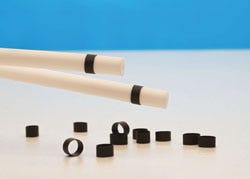Reducing Costs, One Marker Band at a Time
November 30, 2012
|
Polymer marker bands are an alternative to traditional marker bands made from gold or platinum. |
As companies struggle to meet the ever-growing demands of a changing healthcare system, the pressure facing medical device manufacturers to reduce costs is palpable. To cut costs while maintaining medical device functionality, Putnam Plastics Corp. (Dayville, CT) has developed a line of polymer marker bands for fluoroscopic illumination of catheter tips. An alternative to traditional marker bands made from gold or platinum, the new bands, according to the supplier, not only reduce the use of expensive materials but also eliminate the need to crimp or swage metal tips to catheter shafts.
"Gold and platinum are highly visible under x-ray, which is important for catheters," explains Dan Lazas, marketing director of Putnam Plastics. "Catheter tips require visibility for placement of balloons, stents, and other devices in the desired vascular location." However, such metal tips are expensive in a several ways. For example, the cost of precious materials is high and getting higher, Lazas says. "There is no getting around the fact that prices for precious metals have gone up."
In addition, the process used to manufacture and attach gold and platinum marker bands is expensive, Lazas notes. First, a multistep forming process is required to create seamless, small-diameter precious metal tubes that are then cut to specified band lengths. Then, the metal bands are often crimped or swaged to the catheter shaft employing specialized equipment. Besides being complicated, the process of securing gold or platinum bands to polymer shafts requires rigorous quality assurance to ensure that the bands remain in place during procedures.
In contrast to this multistep production process, Putnam Plastics relied on design for manufacturability to develop a continuous manufacturing technique that is substantially leaner, Lazas comments. The company's polymer marker bands for catheter tips are extruded into tubes from tungsten-filled polymers such as nylons, urethanes, or thermoplastic elastomers. Customized using the same polymer as the catheter shaft, the bands can be adhesive or thermally bonded to ensure secure assembly. "Like polymers offer the potential for improved bonding," Lazas says. "For example, thermal bonding of an 80% tungsten-filled Pebax marker band to a Pebax catheter shaft offers greater adhesion than if the band and shaft materials were dissimilar."
Featuring inside diameters ranging in size from 0.014 to 0.200 in. and walls ranging in thickness from 0.002 to 0.030 in., the new marker bands contain an unfilled polymeric outer surface similar to the catheter surface, providing a smooth band surface that minimizes trauma to blood vessels. In addition, the tungsten loadings ranging between 65 and 80% by weight meet radiopacity requirements, enabling surgeons to visualize the catheter features within the body to deploy a variety of medical devices.
About the Author(s)
You May Also Like


